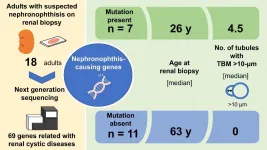Bacteria and viruses infect our cells through sugars: Now researchers want to know how they do it
2021-04-23
(Press-News.org) Sugar is not just something we eat. On the contrary. Sugar is one of the most naturally occurring molecules, and all cells in the body are covered by a thick layer of sugar that protects the cells from bacteria and virus attacks. In fact, close to 80 per cent of all viruses and bacteria bind to the sugars on the outside of our cells.
Sugar is such an important element that scientists refer to it as the third building block of life - after DNA and protein. And last autumn, a group of researchers found that the spike protein in corona virus needs a particular sugar to bind to our cells efficiently.
Now the same group of researchers have completed a new study that further digs into the cell receptors to which sugars and thus bacteria and virus bind.
'We have established how the sugars bind to and activate the so-called Siglec receptors that regulate immunity. These receptors play a major role, as they tell the immune system to decrease or increase activities. This is an important mechanism in connection with autoimmune diseases', says the first author of the study, Postdoc Christian Büll from the Copenhagen Center for Glycomics (CCG) at the University of Copenhagen.
The unique sugar language
When the immune system receives wrong signals, it can lead to autoimmune diseases, which is when the immune system attacks itself. The Siglec receptors receive signals via the sialic acid sugar, a carbohydrate that typically closes the sugar chains on the surface of our cells. When Siglec receptors meet the right sugar chains, the immune system is told to dampen or activate.
'As part of the new study, we have created a cell library that can be used to study how various sugars bind to and interact with receptors. We have done this by creating tens of thousands of cells each containing a bit of the unique sugar language, which enables us to distinguish them from one another and to study their individual effect and process. This knowledge can help us develop better treatment options in the future', says Associate Professor Yoshiki Narimatsu from CCG, who also contributed to the study.
'The surface of the cells in the library is the same as the one found on cells in their natural environment. This means that we can study the sugars in an environment with the natural occurrence of e.g. proteins and other sugars, and we can thus study the cells in the form in which virus and bacteria find them', Yoshiki Narimatsu explains.
Important discovery for Alzheimer's
Working on the new study, the researchers identified the sugars that bind to the specific receptor that plays a main role in the development of Alzheimer's disease.
'Our main finding concerns the Siglec-3 receptor. Mutations in the Siglec-3 receptor is already known to play a role in connection with Alzheimer's, but we did not know what the receptor specifically binds to. Our method has now identified a potential natural sugar that binds specifically to the Siglec-3 receptor. This knowledge represents an important step forwards in understanding the genetic defects that cause a person to develop the disease', says Christian Büll.
INFORMATION:
The creation of the sugar libraries was funded by the Lundbeck Foundation and the Danish National Research Foundation.
ELSE PRESS RELEASES FROM THIS DATE:
2021-04-23
Researchers at Tokyo Medical and Dental University (TMDU) in a pioneering study identify clinical, genetic and histopathological characteristics that may help confirm the diagnosis when nephronophthisis occurs in adults
Tokyo, Japan - Nephronophthisis (NPH) is a kidney disease affecting mainly children. Now, for the first time, researchers at Tokyo Medical and Dental University (TMDU) have studied a number of adults with NPH and highlighted clinical, genetic and pathological characteristics that could help in confirming this challenging diagnosis.
NPH is inherited in an autosomal recessive pattern and, though rare, is the commonest genetic cause of kidney failure in children. The ...
2021-04-23
It is 2,250 kilometers long, but only 355 kilometers wide at its widest point - on a world map, the Red Sea hardly resembles an ocean. But this is deceptive. A new, albeit still narrow, ocean basin is actually forming between Africa and the Arabian Peninsula. Exactly how young it is and whether it can really be compared with other young oceans in Earth's history has been a matter of dispute in the geosciences for decades. The problem is that the newly formed oceanic crust along the narrow, north-south aligned rift is widely buried under a thick blanket of salt and sediments. This complicates direct investigations.
In the international journal Nature Communications, scientists from GEOMAR Helmholtz Centre for Ocean Research Kiel, ...
2021-04-23
Tsukuba, Japan - Blood vessels can be injured by the build-up of atherosclerosis and long-standing hypertension, among other conditions. As a consequence, blood vessels may undergo a process called remodeling, whereby their walls thicken and cause blockages (known as occlusion). In a new study, researchers from the University of Tsukuba discovered how cells marked by platelet-derived growth factor receptor alpha (PDGFRa+) residing predominantly in the most outer layer of blood vessels contribute to their remodeling.
Blood vessels comprise three layers, each of which fulfills a unique role ...
2021-04-23
Single-molecule fluorescence detection (SMFD) is able to probe, one molecule at a time, dynamical processes that are crucial for understanding functional mechanisms in biosystems. Fluorescence in the Near-infrared (NIR) offers improved Signal to Noise Ratio (SNR) by reducing the scattering, absorption and autofluorescence from biological cellular or tissue samples, therefore, provides high imaging resolution with increased tissue penetration depth that are important for biomedical applications. However, most NIR-emitters suffer from low quantum yield, the weak NIR fluorescence signal makes the detection extremely difficult.
Plasmonic nanostructures are capable of converting localized electromagnetic energy into free radiation ...
2021-04-23
Strawberry geranium (Saxifraga stolonifera) has been used in Japan as a herbal medicine to treat wounds and swelling, and continues to be an ingredient in food and cosmetics. Pharmacological studies have shown that extracts of strawberry geranium have antioxidant and antitumor activities. However, the anti-inflammatory effect of strawberry geranium on the skin had not been well characterized.
This study, first-authored by associate professor Takeshi Kawahara of the Institute of Agriculture, Shinshu University for a joint research project with Maruzen Pharmaceutical Co., ...
2021-04-23
Dr. Sabrina Coninx from Ruhr-Universität Bochum and Dr. Peter Stilwell from McGill University, Canada, have investigated how philosophical approaches can be used to think in new ways about pain and its management. The researchers advocate not merely reducing chronic pain management to searching and treating underlying physical changes but instead adopting an approach that focuses on the person as a whole. Their work was published online in the journal "Synthese" on 15 April 2021.
It is not currently possible to treat chronic pain effectively in many cases. This has encouraged researchers from various disciplines to consider new approaches ...
2021-04-23
A team led by Prof. GUO Guangcan and Prof. ZOU Changling from the University of Science and Technology of China of the Chinese Academy of Sciences realized efficient frequency conversion in microresonators via a degenerate sum-frequency process, and achieved cross-band frequency conversion and amplification of converted signal through observing the cascaded nonlinear optical effects inside the microresonator. The study was published in Physics Review Letters.
Coherent frequency conversion process has wide application in classical and quantum information fields such as communication, detection, ...
2021-04-23
A new study conducted jointly by the University of Liege (Belgium) and the Ecole normale superieure - PSL (France) shows that heart brain interactions, measured using electroencephalography (EEG), provide a novel diagnostic avenue for patients with disorders of consciousness. This study is published in the Journal of Neuroscience.
Catherine Tallon-Baudry (ENS, CNRS) introduces : "The scientific community already knew that in healthy participants, the brain's response to heartbeats is related to perceptual, bodily and self-consciousness. We now show that we can obtain clinically meaningful information if we probe this interaction in ...
2021-04-23
Networks offer a powerful way to visualize and analyze complex systems. However, depending on the size and complexity of the network, many visualizations are limited. Protein interactions in the human body constitute such a complex system that can hardly be visualized. Jörg Menche, Adjunct Principal Investigator at the CeMM Research Center for Molecular Medicine of the Austrian Academy of Sciences, Professor at the University of Vienna and research group leader at Max Perutz Labs (Uni Wien/MedUni), and his team developed an immersive virtual reality (VR) platform that solves ...
2021-04-23
Software using artificial intelligence, AI, is revolutionizing how microscopy images are analysed. For instance, AI can be used to detect features in images (i.e., tumours in biopsy samples) or improve the quality of images by removing unwanted noise. However, non-experts continue to find AI technologies difficult to use.
In the article "Democratising deep learning for microscopy with ZeroCostDL4Mic", published in Nature Communications on 15 April 2021, researchers describe a platform called ZeroCostDL4Mic, which makes these AI technologies accessible to everyone.
"The key novelty is that ZeroCostDL4Mic runs in the cloud for free and does not ...
LAST 30 PRESS RELEASES:
[Press-News.org] Bacteria and viruses infect our cells through sugars: Now researchers want to know how they do it




